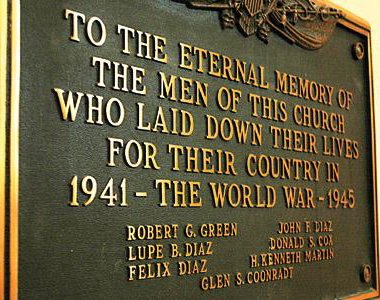|
Stories Behind the Plaque
DAVID NAMANNY/Mitchell County Press-News
OSAGE — There’s a bronze plaque on the wall of the First Baptist Church in Osage that lists the names of several members of the church who died in service to their country during World War II.
Among those names are three brothers from Osage: John Diaz, Lupe Diaz and Felix Diaz. Their father was Baldo Diaz, who worked as a custodian at the Mitchell County Courthouse. Their mother’s name was Angela.
Felix Diaz was a 1943 state wrestling champion for Osage; just a year later, he was serving as a gunner on a B-17 bomber that was shot down over Europe.
His brother, Lupe Diaz, made it home to Osage in 1945, only to die shortly after from wounds he received in combat.
The third brother, John, was taken prisoner of war by the Japanese.
His story is both fascinating and horrifying, some of it recounted in the book, “Last Man Out,” which documents the Palawan Massacre, where John Diaz was killed.
According to the book, John Diaz was taken prisoner on Corregidor in the opening days of World War II. He survived the Bataan Death March and hard labor building an airfield for the Japanese.
On Dec. 14, 1944, the Japanese herded the remaining 150 POWs at Puerto Princesa into three covered trenches which were then set on fire using barrels of gasoline. The Japanese wanted to prevent the rescue of prisoners of war by the advancing Allies on the Philippine Islands.
As prisoners tried to escape the flames they were shot down. Some escaped by going over a cliff that ran along one side of the trenches, but were later hunted down and killed.
A few survived by digging out an end of a bluff on the ocean.
Most in the water were caught and executed. Most of those who survived burrowed into the smelly refuge dump and missed being bayoneted. They slipped out at night and swam to a nearby island. Only 11 men escaped the slaughter and between 133 and 141 were killed. John Diaz was one of them.
The survivors, including former Marine Glenn McDole of Ankeny, remembered their friend’s names in the pages of “Last Man Out.”
“And not to be forgotten were the Iowans, their bodies scattered around the prison compound: Glen Teel of Columbus Junction and Wilfred Kerns of Madrid and John Diaz of Osage. They had suffered greatly.”
From the Aug. 10, 1944, Mitchell County Press:
Pfc. John Diaz, whose fate has been unknown by his parents since March, 1942, is a prisoner of the Japanese in the Philippine Islands, according to a government message received Saturday forenoon.
It was known John was a prisoner as the family was notified in 1942, after Pearl Harbor, but nothing had been heard from him since.
The parents refused to give up hope he was alive, however, and made every effort to learn something concerning him.
The message Saturday came through the Red Cross and was due to the efforts of Frank Kingsbury, county chairman.
John Diaz entered the service in 1940 and was stationed in the Philippines a few months before the assault on the islands by the Japanese in December 1942.
Then there was an interval of nearly three months before the family heard through government channels that he was a prisoner. No word has come directly from John since his capture.
David Namanny is editor of the Mitchell County News-Press, a Lee Enterprises newspaper.
|
